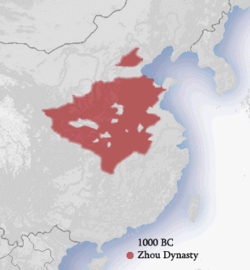State of Zhou
| Zhou dynasty | ||||||||||
| 周朝 | ||||||||||
|
||||||||||
|
Population concentration and boundaries of the Western Zhou dynasty (1050–771 BC) in China
|
||||||||||
| Capital | ||||||||||
| Languages | Old Chinese | |||||||||
| Religion | Chinese folk religion, Ancestor worship, Heaven worship | |||||||||
| Government | Monarchy | |||||||||
| King | ||||||||||
| • | c. 1046–1043 BC | King Wu | ||||||||
| • | 781–771 BC | King You | ||||||||
| • | 770–720 BC | King Ping | ||||||||
| • | 314–256 BC | King Nan | ||||||||
| History | ||||||||||
| • | Battle of Muye | c. 1046 BC | ||||||||
| • | Gonghe Regency | 841–828 BC | ||||||||
| • | Relocation to Wangcheng | 771 BC | ||||||||
| • | Deposition of King Nan by Qin | 256 BC | ||||||||
| • | Fall of the last Zhou holdouts | 249 BC | ||||||||
| Population | ||||||||||
| • | 273 BC est. | 30,000,000 | ||||||||
| • | 230 BC est. | 38,000,000 | ||||||||
| Currency | Mostly spade coins and knife coins | |||||||||
|
||||||||||
| Today part of |
|
|||||||||
| Zhou dynasty | |||||||||||||||||||||||||||||||||

"Zhou" in ancient bronze script (top), seal script (middle), and regular (bottom) Chinese characters
|
|||||||||||||||||||||||||||||||||
| Chinese | 周 | ||||||||||||||||||||||||||||||||
|---|---|---|---|---|---|---|---|---|---|---|---|---|---|---|---|---|---|---|---|---|---|---|---|---|---|---|---|---|---|---|---|---|---|
|
|||||||||||||||||||||||||||||||||
| Transcriptions | |
|---|---|
| Standard Mandarin | |
| Hanyu Pinyin | Zhōu |
| Gwoyeu Romatzyh | Jou |
| Wade–Giles | Chou1 |
| IPA | [ʈʂóu] |
| Wu | |
| Romanization | Tseu |
| Yue: Cantonese | |
| Yale Romanization | Jāu |
| Jyutping | Zau1 |
| Southern Min | |
| Hokkien POJ | Chiu |
| Tâi-lô | Tsiu |
| Old Chinese | |
| Baxter-Sagart | *tiw |
The Zhou dynasty (Chinese: 周朝; pinyin: Zhōu cháo [ʈʂóu ʈʂʰǎu]) was a Chinese dynasty that followed the Shang dynasty and preceded the Qin dynasty. Although the Zhou dynasty lasted longer than any other dynasty in Chinese history, the actual political and military control of China by the dynasty, surnamed Ji (Chinese: 姬), lasted only until 771 BC, a period known as the Western Zhou.
This period of Chinese history produced what many consider the zenith of Chinese bronze-ware making. The dynasty also spans the period in which the written script evolved into its almost-modern form with the use of an archaic clerical script that emerged during the late Warring States period.
According to Chinese mythology, the Zhou lineage began when Jiang Yuan, a consort of the legendary Emperor Ku, miraculously conceived a child, Qi "the Abandoned One", after stepping into the divine footprint of Shangdi. Qi was a culture hero credited with surviving three abandonments by his mother and with greatly improving Xia agriculture, to the point where he was granted lordship over Tai and the surname Ji by his own Xia king and a later posthumous name, Houji "Lord of Millet", by the Tang of Shang. He even received sacrifice as a harvest god. The term Hòujì was probably an hereditary title attached to a lineage.
...
Wikipedia

